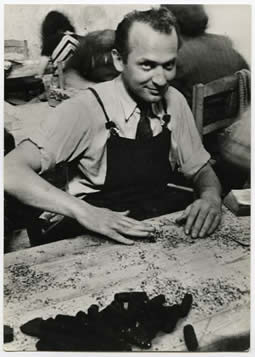
Paul Jean Flandrin (28 May 1811, Lyon - 8 March 1902, Paris) was a French painter. [1] He was the younger brother of the painters Auguste Flandrin and Hippolyte Flandrin. [2]

Paul Jean Flandrin (28 May 1811, Lyon - 8 March 1902, Paris) was a French painter. [1] He was the younger brother of the painters Auguste Flandrin and Hippolyte Flandrin. [2]
Flandrin first trained with Antoine Duclaux (a landscape painter and animal painter from Lyon) and Jean-François Legendre-Héral (a sculptor), before joining the École des beaux-arts de Lyon, then the École des beaux-arts de Paris. He then joined the studio of Dominique Ingres. He competed for the prix de Rome twice and was unsuccessful both times, but still managed to get to Rome at his own expense, joining his brother Hippolyte, who had already won the prize. They spent four years in Rome, during which Paul specialized in landscape painting, making studies after nature which he later worked up into history paintings for the Paris salons. He also regularly collaborated with his brother, providing the landscape backgrounds for the latter's works.
As well as being one of the most notable proponents of the classical landscape tradition alongside Édouard Bertin and Alexandre Desgoffe (whose daughter Aline he married in 1852), Paul Flandrin evolved later in his career towards a more naturalistic style. He also produced portraits in oils and pencil as well as caricatures. He and Aline Desgoffe had one child, Joseph Flandrin (1857-1939), who became an architect and was the father of the painter Marthe Flandrin (1904-1987).

Jean-Hippolyte Flandrin was a French Neoclassical painter. His most celebrated work, Jeune Homme Nu Assis au Bord de la Mer, from 1836, is held in the Louvre.

Théodore Chassériau was a Dominican-born French Romantic painter noted for his portraits, historical and religious paintings, allegorical murals, and Orientalist images inspired by his travels to Algeria. Early in his career he painted in a Neoclassical style close to that of his teacher Jean-Auguste-Dominique Ingres, but in his later works he was strongly influenced by the Romantic style of Eugène Delacroix. He was a prolific draftsman, and made a suite of prints to illustrate Shakespeare's Othello. The portrait he painted at the age of 15 of Prosper Marilhat, makes Théodore Chassériau the youngest painter exhibited at the Louvre museum.

François Marius Granet was a French painter.

French art consists of the visual and plastic arts originating from the geographical area of France. Modern France was the main centre for the European art of the Upper Paleolithic, then left many megalithic monuments, and in the Iron Age many of the most impressive finds of early Celtic art. The Gallo-Roman period left a distinctive provincial style of sculpture, and the region around the modern Franco-German border led the empire in the mass production of finely decorated Ancient Roman pottery, which was exported to Italy and elsewhere on a large scale. With Merovingian art the story of French styles as a distinct and influential element in the wider development of the art of Christian Europe begins.

Anne-François-Louis Janmot was a French painter and poet.

Pierre Henri Révoil was a French painter in the troubadour style.

The Lyon School is a term for a group of French artists which gathered around Paul Chenavard. It was founded by Pierre Revoil, one of the representatives of the Troubadour style. It included Victor Orsel, Louis Janmot and Hippolyte Flandrin, and was nicknamed "the prison of painting" by Charles Baudelaire. It was principally inspired by philosophical-moral and religious themes, and as a current was closely related to the British Pre-Raphaelite painters and poets.

Jean Alexis Achard (1807–1884) was a French painter.

Jacques-Henri Sablet was a Swiss-French painter, part of a family of artists of Swiss origin. He was also known as Franz der Römer, Giacomo Sablez, Giacomo Sablé, Jacob Henry Sablet, Sablet le Jeune, Sablet le Romain or le peintre du Soleil.

Jules-Claude Ziegler (1804-1856) was a French painter, ceramicist and photographer of the French school.

Sébastien-Melchior Cornu was a French painter, specializing in religious works and portraits.

Charles Alexandre Bertier was a French landscape painter.
Camille-Auguste Gastine was a French painter.

Jean-Baptiste Frénet (1814-1889) was a French painter, sculptor, photographer and politician based in Lyon.

Jacques Hérold was a prominent surrealist painter born in Piatra Neamț, Romania.

Portrait of Napoleon III, or initially called in French Portrait de S. M. l'Empereur is an oil painting of 1861 by the French painter Hippolyte Flandrin, depicting France's Emperor Napoleon III standing in his Grand Cabinet. It is held at the Musée de l'Histoire de France, in Paris. At its first presentation in the Universal Exhibition in 1862, the painting attracted praise for its true-to-life representation of Napoleon III.

Portrait of Madame Oudiné is an oil-on-canvas painting by the French artist Hippolyte Flandrin, executed in 1840, now in the Musée des Beaux-Arts de Lyon.

Joseph Benoît Guichard was a French painter and art teacher who worked in a variety of styles.

Hippolyte-Dominique Berteaux was a French painter who specialized in murals and portraits.

Michel Dumas was a French painter, primarily of religious subjects.